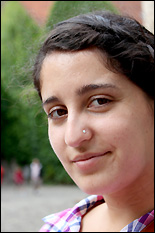
The best thing about my UMD experience was collaborating with other graduate students.
Currently, Patricia is a postdoctoral researcher in the Netherlands developing instruments and models used to analyze air quality.
Class of: 2010 (Ph.D.)
We chatted with Patricia to learn more about her experiences at the University of Maryland, and find out what she's doing We chatted with Patricia to learn more about her experiences at the University of Maryland, and find out what she's doing today.
What kind of research did you do while you were at UMD?
I worked with CMAQ, the primary air quality model used by the EPA [Environmental Protection Agency] and state environmental agencies to predict future air quality, determine regional compliance with air quality standards, and to write future air quality legislation. Critically analyzing CMAQ's ability to simulate air quality is important for industrial stakeholders, state and regional agencies, and public health. I analyzed the ability of CMAQ to simulate tropospheric ozone and its precursors using surface and aircraft measurements of various trace gases.
I also worked on implementing a new instrument to measure NO2 using cavity ring-down spectroscopy (CRDS). This technique, unlike the currently widely used hot molybdenum catalysts followed chemiluminescence, is specific to NO2. Developing NO2-specific monitoring instruments is needed in order to support the analysis of air quality models, and to demonstrate compliance with new tougher NO2 standards.
Where do you currently work, and what you are doing now?
I am currently a postdoc at the Royal Netherlands Meteorological Institute (KNMI) working with data from the Ozone Monitoring Instrument (OMI). The primary focus of my research is to take advantage of the long record of NO2 tropospheric columns observed by the OMI to analyze trends in air pollution over Europe.
What led you to this position?
I really like to travel and explore new places. As a graduate student I ended up visiting five new countries both through personal and scientific trips. A postdoc is the perfect opportunity to live in a foreign country...I can live anywhere for two years! [My advisors, Dr.] Russ [Dickerson] and [Professor] Sheryl [Ehrman] were both very supportive, probably because they also did postdocs abroad. Russ' previous graduate student had been at postdoc at KNMI, which is how I [made my] contact[s] here.
Why did you choose to major in and have a career in chemical and biomolecular engineering?
As an undergraduate I majored in chemistry and mathematics. I chose to have a career in chemical engineering because I thought it would be a great application of both. I found that chemical engineering is a general enough field that it can prepare you for a career in many areas of science and technology.
Why did you choose UMD and the Department of Chemical and Biomolecular Engineering?
I chose UMD because it was the best engineering school in the D.C. Metro area. I found in my undergraduate research at UMD that being located near the various national labs gives you access to many unique (and the best) facilities in the country.
What was the best thing about your UMD experience?
The best thing about my UMD experience was collaborating with other graduate students. They were the "best‚ and sometimes harshest, critics" when it came to giving presentations and writing papers. Their feedback was invaluable.
What did you like about living and working in the D.C. Metro area?
I think the D.C. Metro area is a great place to be a graduate student because it is filed with other young professionals from all walks of life. It's a cultural melting pot where you can very easily meet people from every part of the world. Also, you're just a few hours away from great nature in the Shenandoah Valley, or big cities like Philadelphia and New York.
What advice do you have for undergraduates considering graduate studies in ChBE?
I think one of the best pieces of advice I received as an undergraduate was to take as many math classes as possible. Once you don't have to worry about how to do the math, you can focus on science.
What advice do you have for current graduate students in ChBE who are working on their M.S. or Ph.D.?
If you have an interest outside of chemical engineering, it doesn't hurt to pursue it. Collaborating with people outside of your field may help you generate new and novel ideas.today.
What kind of research did you do while you were at UMD?
I worked with CMAQ, the primary air quality model used by the EPA [Environmental Protection Agency] and state environmental agencies to predict future air quality, determine regional compliance with air quality standards, and to write future air quality legislation. Critically analyzing CMAQ's ability to simulate air quality is important for industrial stakeholders, state and regional agencies, and public health. I analyzed the ability of CMAQ to simulate tropospheric ozone and its precursors using surface and aircraft measurements of various trace gases.
I also worked on implementing a new instrument to measure NO2 using cavity ring-down spectroscopy (CRDS). This technique, unlike the currently widely used hot molybdenum catalysts followed chemiluminescence, is specific to NO2. Developing NO2-specific monitoring instruments is needed in order to support the analysis of air quality models, and to demonstrate compliance with new tougher NO2 standards.
Top